Intro
Identify tick bite rash symptoms, including Lyme disease signs, bullseye rashes, and tick-borne illness indicators, to seek timely medical attention and prevent complications.
Tick bites can be a significant concern, especially during outdoor activities in areas where ticks are prevalent. While most tick bites are harmless, some can transmit diseases like Lyme disease, Rocky Mountain spotted fever, and Southern tick-associated rash illness (STARI). Understanding the symptoms of a tick bite rash is crucial for prompt medical attention and effective treatment. The importance of recognizing these symptoms cannot be overstated, as early detection can significantly impact the outcome of tick-borne illnesses.
Recognizing the symptoms of a tick bite rash is essential for individuals who spend time outdoors, particularly in wooded, bushy, or grassy areas. Ticks are most active during warmer months, and their bites can be painless, making it easy to overlook the initial bite. However, as the tick feeds on blood, it can transmit bacteria, viruses, or other pathogens into the bloodstream, leading to various symptoms, including a rash. Being aware of these symptoms can help individuals seek medical attention promptly, reducing the risk of long-term complications.
The symptoms of a tick bite rash can vary depending on the type of tick and the disease it transmits. In general, a tick bite rash can appear as a red, expanding rash, often with a distinctive "bull's-eye" pattern. This rash can be accompanied by other symptoms, such as fever, headache, and fatigue. It is essential to monitor the rash and overall health closely after a tick bite, as these symptoms can indicate the presence of a tick-borne illness. By understanding the different types of tick bite rashes and their corresponding symptoms, individuals can take proactive steps to protect themselves and seek medical attention if necessary.
Types of Tick Bite Rashes
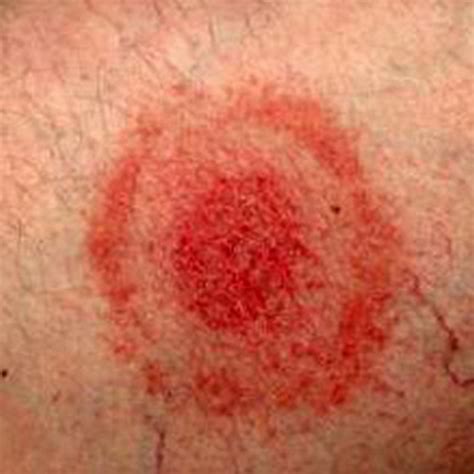
There are several types of tick bite rashes, each associated with a specific disease or condition. The most common types of tick bite rashes include:
- Lyme disease rash: Characterized by a distinctive "bull's-eye" pattern, this rash typically appears within 3-30 days after the tick bite.
- Southern tick-associated rash illness (STARI): This rash is similar to the Lyme disease rash but is typically smaller and disappears within a few days.
- Rocky Mountain spotted fever rash: This rash usually appears 2-5 days after the tick bite and is characterized by small, flat, pink spots that eventually turn purple.
Causes and Risk Factors
The causes and risk factors associated with tick bite rashes are essential to understand, as they can help individuals take preventive measures. Ticks are the primary vectors of tick-borne illnesses, and their bites can transmit a range of pathogens. The risk of tick bites is higher in certain areas, such as wooded, bushy, or grassy regions, and during specific times, like warmer months. Individuals who engage in outdoor activities, such as hiking, camping, or gardening, are also at a higher risk of tick bites.Symptoms of Tick Bite Rash
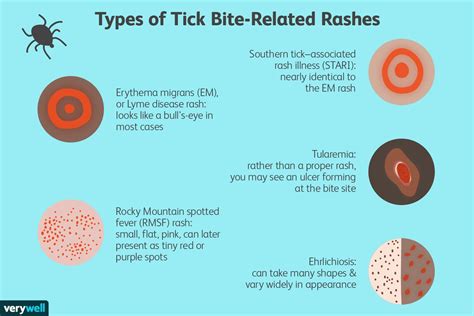
The symptoms of a tick bite rash can vary depending on the underlying disease or condition. Common symptoms include:
- Red, expanding rash
- Fever
- Headache
- Fatigue
- Muscle or joint pain
- Swollen lymph nodes
Diagnosis and Treatment
Diagnosing a tick bite rash typically involves a physical examination, medical history, and laboratory tests. The treatment for tick bite rashes depends on the underlying disease or condition. In general, antibiotics are effective in treating most tick-borne illnesses, especially when started promptly. It is essential to seek medical attention if symptoms persist or worsen over time.Prevention and Protection
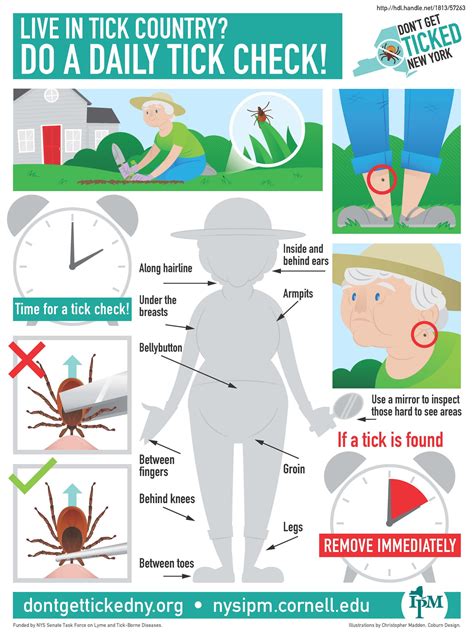
Preventing tick bites is crucial to reducing the risk of tick-borne illnesses. Individuals can take several measures to protect themselves, including:
- Using insect repellents
- Wearing protective clothing
- Conducting regular tick checks
- Avoiding tick-prone areas
- Using permethrin-treated clothing and gear
Complications and Long-Term Effects
If left untreated, tick-borne illnesses can lead to complications and long-term effects. For example, Lyme disease can cause neurological problems, heart issues, and joint pain if not treated promptly. Rocky Mountain spotted fever can lead to serious complications, such as amputation, if not treated aggressively. Understanding the potential complications and long-term effects of tick-borne illnesses can help individuals seek medical attention promptly and take proactive steps to protect themselves.Tick Bite Rash in Different Regions
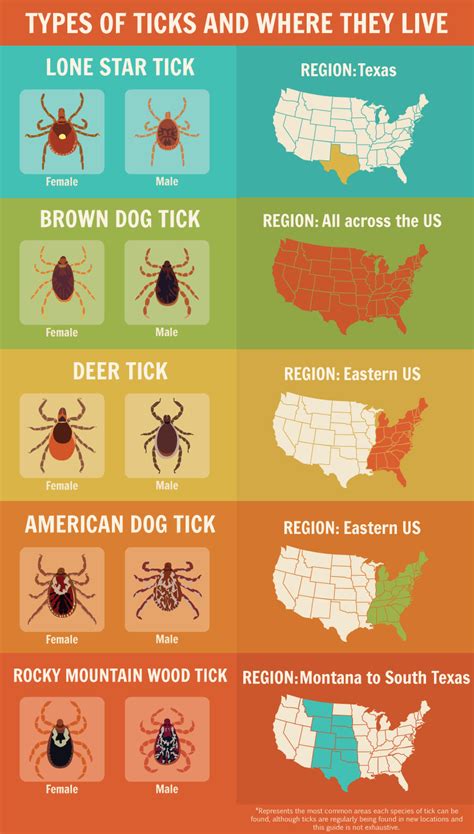
The types of tick bite rashes and their corresponding diseases can vary depending on the region. For example:
- In the United States, Lyme disease is most common in the Northeast and Midwest.
- In Europe, tick-borne encephalitis is a significant concern.
- In Australia, ticks can transmit diseases like Queensland tick typhus.
Current Research and Developments
Researchers are continually working to improve our understanding of tick-borne illnesses and develop effective treatments. Current research focuses on: * Developing vaccines against tick-borne diseases * Improving diagnostic tests for tick-borne illnesses * Investigating the role of climate change in tick populations and disease transmissionPublic Awareness and Education
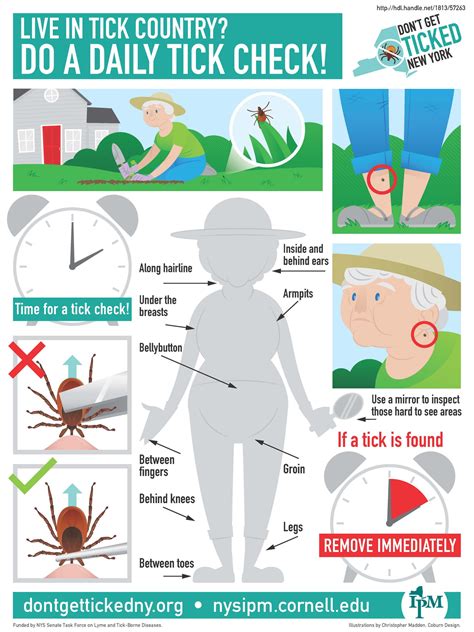
Public awareness and education are crucial in preventing tick-borne illnesses. Individuals can take steps to protect themselves by:
- Learning about tick-borne diseases and their symptoms
- Understanding the risks associated with tick bites
- Taking preventive measures, such as using insect repellents and conducting regular tick checks
Conclusion and Future Directions
In conclusion, tick bite rashes are a significant concern, and understanding their symptoms, causes, and risk factors is essential for prompt medical attention and effective treatment. By taking proactive steps to protect themselves and seeking medical attention if necessary, individuals can reduce the risk of tick-borne illnesses. Future research directions include developing effective vaccines, improving diagnostic tests, and investigating the role of climate change in tick populations and disease transmission.What are the common symptoms of a tick bite rash?
+The common symptoms of a tick bite rash include a red, expanding rash, fever, headache, fatigue, muscle or joint pain, and swollen lymph nodes.
How can I prevent tick bites?
+You can prevent tick bites by using insect repellents, wearing protective clothing, conducting regular tick checks, avoiding tick-prone areas, and using permethrin-treated clothing and gear.
What are the potential complications of tick-borne illnesses?
+If left untreated, tick-borne illnesses can lead to complications and long-term effects, such as neurological problems, heart issues, and joint pain.
How can I remove a tick from my skin?
+You can remove a tick from your skin by using fine-tipped tweezers to grasp the tick as close to your skin as possible and pulling upward with steady, even pressure.
What should I do if I suspect I have a tick-borne illness?
+If you suspect you have a tick-borne illness, you should seek medical attention promptly. Your healthcare provider can diagnose and treat the illness, and provide guidance on how to manage symptoms and prevent long-term complications.
We hope this article has provided you with valuable information about tick bite rashes and their symptoms. If you have any further questions or concerns, please do not hesitate to comment below. Share this article with your friends and family to help raise awareness about tick-borne illnesses and the importance of prevention and early detection. Take proactive steps to protect yourself and your loved ones from tick bites, and seek medical attention if you suspect you have a tick-borne illness. By working together, we can reduce the risk of tick-borne illnesses and promote a healthier, safer community.
